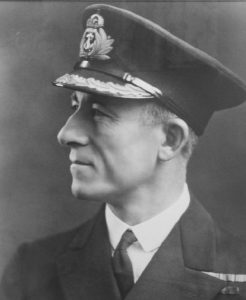Capt. Russell Grenfell RN (1892 - 1954)
 GRENFELL, CAPT. RUSSELL (1892 – 1954), naval officer and author, was born on April 10th 1892, the second son of Capt. Hubert Henry Grenfell RN and his wife, Eleanor Kate Cunningham.
GRENFELL, CAPT. RUSSELL (1892 – 1954), naval officer and author, was born on April 10th 1892, the second son of Capt. Hubert Henry Grenfell RN and his wife, Eleanor Kate Cunningham.
Educated as a cadet at Osborne from 1905 Grenfell first went to sea in 1909. He was promoted Lieutenant in June 1914, and appointed to the gunboat Thistle, in China. On the outbreak of war later in the year the Thistle was paid off and he joined the Triumph, which took part in the reduction of the Tsingtau forts and was later sunk by a German submarine, U-21, during the Dardanelles operations. From December 1915, he served in the new battleship Revenge, which was the ship to which Vice-Admiral Burney transferred his flag after the Marlborough had been torpedoed during the Battle of Jutland. He later presented the White Ensign from HMS Revenge at Jutland to the church in St Just in Penwith in Cornwall, from where the Grenfell family originated.
In the latter part of the war he commanded destroyers on convoy duty in the Channel and North Atlantic. After the end of hostilities he graduated from the Naval Staff College, served in the Queen Elizabeth and the Iron Duke, fleet flagships on the Home and Mediterranean stations, and also as second-in-command of the cruisers Calypso and Cumberland. His last post before his retirement from the Royal Navy in 1937 was as senior commander on the staff of the Royal Naval Staff College, Greenwich.
He was descended from an old naval family as in addition to his father, his grandfather, Capt. Henry Duncan Preston Cunningham RN, and two of his great-grandfathers having been naval officers, and his brother was Capt. Francis Henry Grenfell, who commanded the Q-ship Penshurst, Q7, in the 1914-18 War and sank the submarines UB17 and UB39. His other grandfather, Rev Algernon Sidney Grenfell was a schoolmaster at Rugby School, Before he left the Navy he had already written a book on cruiser organisation, and after his retirement a stream of books and articles of high quality flowed from his pen almost to the end of his life. As the years went on he became convinced of the need for a navy composed of a larger number of smaller ships and adequate air cover, views which he certainly did not hold when serving but which he attained to after an arduous analysis of the fundamentals of modern war.
His arguments on these tactical and strategical subjects were always moderately and clearly expressed, and their development may be followed in The Art of the Admiral (1937), Sea Power in the next War (1938), and in his lecture delivered early in 1939 at the Royal United Services Institution, Whitehall. Another subject which he made his own was service pay. His attitude to this was as hot and emotional as his attitude to strategy was cool and intellectual, and though his indignation with the decisions of the committees in Whitehall – one of which produced the only serious mutiny in the British Navy in this century was understandable, his advocacy would have been more effective had it been more moderately delivered. His skill in narrative was well shown in The Bismarck Episode and Main Fleet to Singapore, the latter an account of the naval disaster which sealed the fate of Singapore in the opening rounds of the war in the Far East, and his sure grasp of naval strategy was demonstrated again in 1948 in his critical study Nelson the Sailor.
Captain Grenfell, who was formerly Naval Correspondent of the Daily Telegraph, died on Sunday July 4th 1954 at the age of 62.
Obituary in The Times July 8th 1954: Frank Grenfell.

